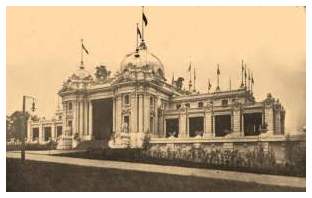Illinois' building stood on a hill not far from the Observation Wheel, it was not on the Plateau of States, but was the important member of another state group on `The Trail,' directly west of the Cascade Gardens. Across the way were the beautiful gardens of Japan, and the Lincoln Museum was directly north.
The building was designed along the lines of the French Renaissance, but
it was entirely modern in treatment. A broad veranda surrounded the building on all sides, while a majestic dome crowned the edifice. The building was designed by a Illinois architects, erected by Illinois labor, and furnished, for themost part, by Illinois firms.
Gigantic statues of Lincoln and Douglas flanked the main entrance and on each side of the drum of the dome stood great sculptural groups, symbolical of agriculture and other industries.
The size of the French Renaissance mansion was 198 by 144 feet and was constructed at a cost of 50,000 dollars. It was dedicated on May 27.
After entering, one could see a broad staircase, to its side was a raised platform, on which stood a grand piano. The elevated apartment served as a reception and music room.
Opening from the great hall were reading rooms, rest rooms, and the office of the commission. On the floor above were the suites of apartments for the governor, the commissioners, and the officers of the building. The wives of the commissioners served as hostesses, each doing the honors for a period of ten days.
The interior was lit by Nernst lamps.* The ceiling of the State room was deeply paneled, and its walls, ornamented with mural paintings—an epical frieze, 6 feet wide, telling the history of Illinois. One hall was devoted to the memory of Abraham Lincoln.
Illinois had grand displays at the Palace of Agriculture (choice specimens of wheat, oats, rye, millet, sorghum, Kaffir corn, clover, broom corn, and other grains and grasses, as well as butter, cheese and all-dairy exhibits), Horticulture as well as the Palace of Mines. Included was a huge exhibit showing the production of coal, and its quarries yield a fine quality of both sand and lime stone. The booth in the Palace of Mines contained the largest block of soft coal ever removed from a mine. It was 6 by 7 by 8 feet in size and was hoisted 335 feet from the shaft.
The live stock from the State of Illinois won one-twentieth of the entire premiums offered by the Louisiana Purchase Exposition.
The state exhibited in many other Palaces, including- Education, and Forestry, Fish and Game.
* Nernst lamps were an early form of electrical incandescent lamps. They did not require a glowing tungsten filament, but used a ceramic rod that was heated to incandescence. There was no need to enclose it within a vacuum or noble gas environment.




